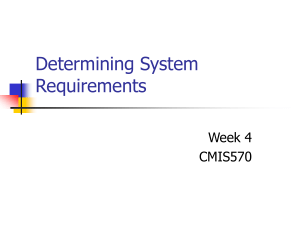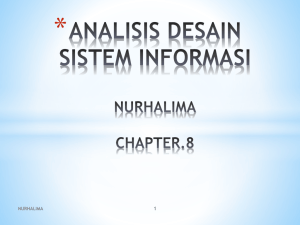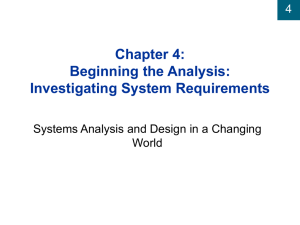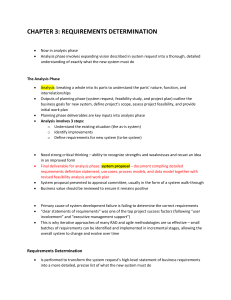Analysis Phase
advertisement
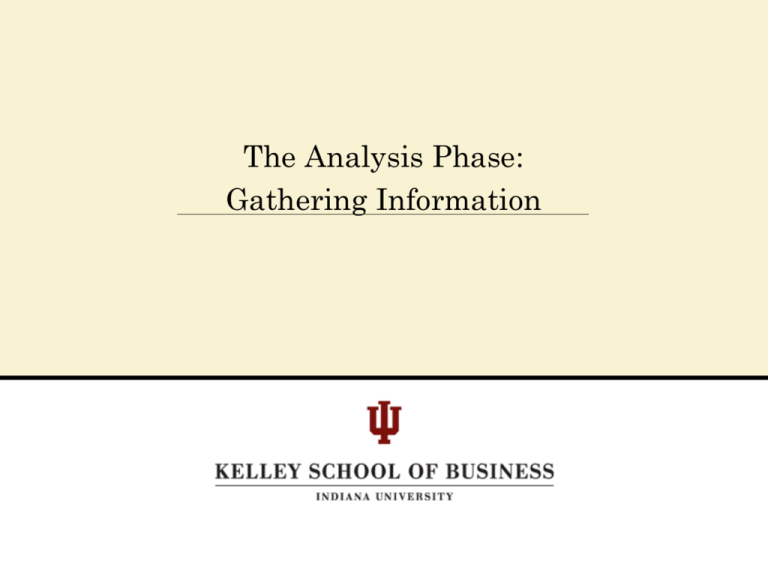
The Analysis Phase: Gathering Information The Analysis Phase The “Analysis Phase” answers the questions of who will use the system, what the system will do, and where and when it will be used. It consists of three stages: – Understanding the “As-Is System” – Identifying the improvements needed to that system – Producing a description of the “To-Be System” Objectives • Understand how to use interviews to gather requirements information • Understand how to use joint application design sessions to gather requirements information • Be familiar with questionnaires • Be familiar with document analysis • Be familiar with observation • Understand when to use each technique Information Gathering Strategies There are many strategies for information gathering, we will focus on five strategies: – Interviews – Joint Application Design (JAD) sessions – Document Analysis – Observation – Questionnaires Information Gathering Strategies Information gathering strategies by degree of intrusiveness – Observation – Document Analysis – Questionnaires – Interviews – Joint Application Design (JAD) sessions Interviews The interview is the most commonly used information-gathering technique. There are five basic steps to the interview process: – Selecting Interviewees – Designing Interview Questions – Preparing for the Interview – Conducting the Interview – Follow-up Joint Application Design (JAD) JAD is an information-gathering technique for large groups – the project team, – users and management JAD is a structured process that requires a skilled facilitator. – The facilitator is the person who sets the meeting agenda and guides the discussion. – The facilitator remains neutral during the discussion. Questionnaires Questionnaires (surveys) are often used when there is a large number of people (the population) who may have the information needed for the project. Instead of interviewing, or even surveying, everyone (this would be a census), a representative sample of the population is taken. Can cover a wider range of the population than interviews, but lack the richness of detail that interviews can provide. Document Analysis Document analysis can be very useful in understanding the as-is system. Provide strong evidence of how the as-is system was intended to operate. However, it is important to distinguish between the formal and informal systems. Documents can help with both. Observation Observation can be used see how the as-is system actually operates. Observation in conjunction with the other techniques is very helpful in distinguishing between the formal and informal systems. – However, an observer must be careful of the “Hawthorne Effect.” Information Gathering Strategies Getting the actual information is not as trivial The "more intrusive" methods (interviews and joint application development) have the advantage of being able to adjust questions based on previous responses but take considerably more time. One approach is to use less intrusive methods first (document analysis and observation) then follow up with the other three methods (interviews, JAD, or questionnaires) based on these findings. Selecting the Appropriate Technique There is no one appropriate technique; each has its strengths and weaknesses. Generally a combination of techniques is best. Consideration should be given to: – Type of Information – Depth of Information – Breadth of Information – Integration of Information – User Involvement – Cost A hypothetical problem • An unscrupulous group of A337 students want to maximize their course grade at the expense of honesty. • They believe that a high final score is the secret. • The students have even gone as far as to offer payments to “analysts” (i.e., past and current A337 students) based on their test “performance” A hypothetical problem • The “analysts” get paid more for presenting their findings earlier • The analysts get a bonus after the fact based on how well the students actually did on the exam. • What would you suggest as a analysis plan for these scoundrels? Consider the methods, “respondents”, and the order you would use.
